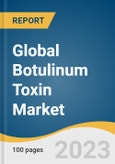The global botulinum toxin market size is expected to reach USD 21.1 billion by 2030, according to the report., registering a CAGR of 9.8% from 2024 to 2030. Botulinum toxin is a drug formed from a toxin built by the bacteria clostridium botulinum. These drugs work by paralyzing or tempering specific muscles or by hindering certain nerves. The effect of the drug lasts for about a few months, depending on the treatment. Botulinum toxin is used for both therapeutic and aesthetic applications. Nowadays, the drug is highly adopted for aesthetic procedures. For instance, Botox is a non-invasive cosmetic procedure and is used to reduce forehead creases, facial fine lines, wrinkles, and crow’s feet among others. The demand for botulinum toxin is expected to grow during the forecast period owing to the growing demand for minimally invasive or non-invasive procedures in aesthetics. Furthermore, increasing application in therapeutic applications, coupled with growing R&D initiatives, is expected to expand the market.
Population aged above 40 years are focusing on the physical features and wish to have a younger look. Thus, rising emphasis on aesthetic beauty, for instance, lip treatments by women, especially in developed countries is anticipated to fuel the industry growth. Also, botulinum toxin is used to treat several age-related conditions such as glabellar lines, crow’s feet, and forehead lines. Hence, people above the age of 40 are more vulnerable to such signs of aging. Therefore, procedures of botulinum toxin are gaining more popularity among individuals aged between 40-55 years, thereby augmenting the industry growth. Furthermore, rising cases of chronic disorders such as migraine and cervical dystonia are likely to drive the market.
The COVID-19 outbreak has significantly affected the market. Initially, due to lockdown and global restrictions being imposed in most countries, many aesthetic treatments and procedures were halted. The COVID-19 pandemic has caused a huge disruption in the supply chain of the overall medical industry. However, the sales of botulinum toxins such as botox observed a surge due to the increased demand during the pandemic. Several plastic surgeons and dermatologists are accrediting the boom to individuals wishing to put their finest appearance for online meetings and conferences and greater time to attend consultations and recover from procedures.
This product will be delivered within 1-3 business days.
Population aged above 40 years are focusing on the physical features and wish to have a younger look. Thus, rising emphasis on aesthetic beauty, for instance, lip treatments by women, especially in developed countries is anticipated to fuel the industry growth. Also, botulinum toxin is used to treat several age-related conditions such as glabellar lines, crow’s feet, and forehead lines. Hence, people above the age of 40 are more vulnerable to such signs of aging. Therefore, procedures of botulinum toxin are gaining more popularity among individuals aged between 40-55 years, thereby augmenting the industry growth. Furthermore, rising cases of chronic disorders such as migraine and cervical dystonia are likely to drive the market.
The COVID-19 outbreak has significantly affected the market. Initially, due to lockdown and global restrictions being imposed in most countries, many aesthetic treatments and procedures were halted. The COVID-19 pandemic has caused a huge disruption in the supply chain of the overall medical industry. However, the sales of botulinum toxins such as botox observed a surge due to the increased demand during the pandemic. Several plastic surgeons and dermatologists are accrediting the boom to individuals wishing to put their finest appearance for online meetings and conferences and greater time to attend consultations and recover from procedures.
Botulinum Toxin Market Report Highlights
- The type A product type segment dominated the market in 2023. This is because type A products including Dysport and Botox are commercially available in the market in most countries and have been clinically tested and proven to be safe and effective in the long term with minimal side effects.
- The therapeutic application segment accounted for 43.0% of the market share
- North America dominated the global market in 2023 with a revenue share of over 46.9% owing to the rising technological advancements for cosmetic treatments and the increasing number of specialists and service providers
- Asia Pacific is expected to register the highest CAGR of 11.1% over the forecast period owing to the growing patient population, rising awareness regarding aesthetic procedures, and rapid technological advancements
This product will be delivered within 1-3 business days.
Table of Contents
Chapter 1 Methodology And Scope
Chapter 2 Executive Summary
Chapter 3 Botulinum Toxin Market: Variables, Trends, & Scope
Chapter 4 Botulinum Toxin Market: Product Type Segment Analysis
Chapter 5 Botulinum Toxin Market: Application Segment Analysis
Chapter 6 Botulinum Toxin Market: End-Use Segment Analysis
Chapter 7 Botulinum Toxin Market: Regional Analysis
Chapter 8 Company Profiles
List of Tables
List of Figures
Companies Profiled
- IPSEN GROUP
- ALLERGEN INC.
- MEDY-TOX, INC.
- METABIOLOGICS
- MERZ PHARMA
- US WORLDMEDS
- EVOLUS
- GALDERMA
- LANZHOU INSTITUTE OF BIOLOGICAL PRODUCTS
Methodology

LOADING...
Table Information
| Report Attribute | Details |
|---|---|
| No. of Pages | 100 |
| Published | November 2023 |
| Forecast Period | 2023 - 2030 |
| Estimated Market Value ( USD | $ 11.1 Billion |
| Forecasted Market Value ( USD | $ 21.1 Billion |
| Compound Annual Growth Rate | 9.8% |
| Regions Covered | Global |
| No. of Companies Mentioned | 9 |









